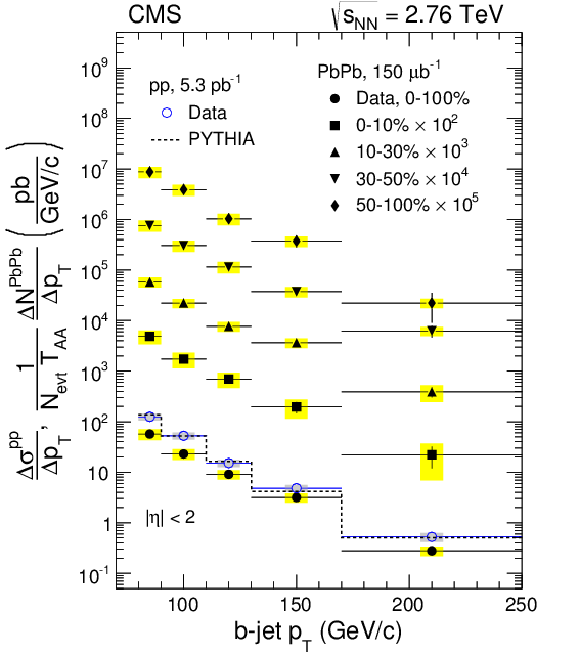

Compact Muon Solenoid
LHC, CERN
| CMS-HIN-12-003 ; CERN-PH-EP-2013-228 | ||
| Evidence of b-jet quenching in PbPb collisions at $\sqrt{s_{NN}}$ = 2.76 TeV | ||
| CMS Collaboration | ||
| 15 December 2013 | ||
| Phys. Rev. Lett. 113 (2014) 132301 [Erratum] | ||
| Abstract: The production of jets associated to bottom quarks is measured for the first time in PbPb collisions at a center-of-mass energy of 2.76 TeV per nucleon pair. Jet spectra are reported in the transverse momentum ($p_T$) range of 80-250 GeV, and within pseudorapidity abs($\eta \lt 2$). The nuclear modification factor ($R_{AA}$) calculated from these spectra shows a strong suppression in the b-jet yield in PbPb collisions relative to the yield observed in pp collisions at the same energy. The suppression persists to the largest values of $p_T$ studied, and is centrality dependent. The $R_{AA}$ is about 0.4 in the most central events, similar to previous observations for inclusive jets. This implies that jet quenching does not have a strong dependence on parton mass and flavor in the jet $p_T$ range studied. | ||
| Links: e-print arXiv:1312.4198 [hep-ex] (PDF) ; CDS record ; inSPIRE record ; Public twiki page ; HepData record ; CADI line (restricted) ; | ||
| PRL Editor's Suggestion, Featured in Physics | |

png ; pdf |
(not a CMS figure) Figure from ``Viewpoint: The Stopping Power of Hot Nuclear Matter'', by Cristina Manuel, IEEC/CSIC, Barcelona (Spain). (Top) When two high-energy protons collide, the partons that compose them (here only quarks are depicted in green, red, and blue) can hit each other. Some of these partons (pink balls) can fly away and ``hadronize,'' forming directional jets of energetic hadrons (white balls). (Bottom) Proton-proton collisions can also occur in the early stages of heavy-ion collisions. In this case the produced jets propagate in a dense quark-gluon-plasma (QGP) fireball. Because of momentum conservation, at least two jets are always generated, traveling in opposite directions. Often, one of the two jets is extinguished, or ``quenched.'' |
| Figures | |

png pdf |
Figure 1-a:
Left: Comparison of SV $ {p_{\mathrm {T}}} $ distribution between data and simulation for the same jet and event selections. The simulation is normalized to the data. Right: Template fit to the SV invariant mass distribution in centrality integrated (0-100%) PbPb collisions for jets of 80 $< {p_{\mathrm {T}}} <$ 90 GeV/$c$. Insets show the same comparisons with the $y$-axis in log scale. |

png pdf |
Figure 1-b:
Left: Comparison of SV $ {p_{\mathrm {T}}} $ distribution between data and simulation for the same jet and event selections. The simulation is normalized to the data. Right: Template fit to the SV invariant mass distribution in centrality integrated (0-100%) PbPb collisions for jets of 80 $< {p_{\mathrm {T}}} <$ 90 GeV/$c$. Insets show the same comparisons with the $y$-axis in log scale. |

png pdf |
Figure 2:
The b-jet yield as a function of $ {p_{\mathrm {T}}} $ is shown for various centrality classes of PbPb collisions as indicated in the legend. The yields are scaled by the equivalent number of minimum bias events sampled and by $ {T_\mathrm {AA}} $. The spectra are also scaled by powers of 10 for visibility. The b-jet cross section in pp collisions is also shown, and compared to PYTHIA. Vertical and horizontal bars represent statistical uncertainties and bin widths, respectively, while filled boxes represent systematics uncertainties. |

png pdf |
Figure 3:
The centrality integrated (0-100%) b-jet $ {R_\mathrm {AA}} $ as a function of $ {p_{\mathrm {T}}} $. Vertical and horizontal bars represent statistical uncertainties and bin widths, respectively, while filled boxes represent systematics uncertainties. The normalization uncertainty from the integrated luminosity in pp collisions and from $ {T_\mathrm {AA}} $ is represented by the green band around unity. The data are compared to pQCD-based calculations from [47]. |

|
Compact Muon Solenoid LHC, CERN |

|

|

|

|

|

|